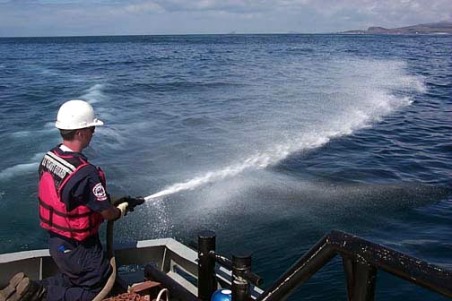By J.P. Kelsey
It seems that since the 2010 BP Deepwater Horizon oil spill, not much attention has been given to exactly how the spill was “cleaned” or how the estimated 14,000 oil spills are cleaned each year. One measure that is often taken to control the amount of oil that reaches coastline is using the chemical dispersant,”Corexit 9500A.” Much is still being discovered about the combination of such dispersants and crude oil, however, increasing the debate over their safety and effectiveness.
Over the past few years, some research has begun to shed light on the effects of such popular cleaning methods and agents. A bath of “Dawn” dish detergent can only be used on a small scale, sadly. Nearly two million gallons of dispersants were estimated to have been used in the DWH spill. Even with the media covering some of the concerns over chemical dispersant use in the case of DWH, the issue took a back seat to lawsuits BP had incurred and their monetary compensation woes. A 2014 study by the University of Texas at Austin ( UT Austin) Marine institute attempted to determine what the effects of crude oil and dispersants are upon marine organisms; Some of their findings have suggested that, when combined, crude oil and dispersants are even more toxic. ”Our results indicate that Corexit 9500A is highly toxic to microzooplankton, particularly to small ciliates, and that the combination of dispersant with crude oil significantly increases the toxicity of crude oil to microzooplankton,” the study concluded. The UT Austin study focused on microzooplankton due to the important role such organisms play in marine ecosystems. These organisms are key players in food webs and their health can be detrimental to the health of larger organisms and ocean health in general. The line of Corexit dispersants work due to their ability to emulsify oil slicks into smaller droplets, thus, increasing the rate at which the oil can be biodegraded and dispersed throughout water columns. Various forms of this cleaner have been used over the past few decades for many oil spills, but unprecedented amounts were used in DWH’s case. It was also used at underwater depths it had not been previously approved, adding to the questions surrounding its effects.
The use of such dispersants is banned in many countries, including the UK. BP has made claims, however, that the dispersant is relatively harmless and becomes too dilute to harm marine life to any significance. More and more research, though, is suggesting to the contrary and that the emulsification of oil that takes place due to the introduction of Corexit can make the oil more bioavailable to organisms. In a study associated with the Gulf Oil Disaster Recovery Group, a legal consortium representing environmental groups and individuals affected by the Deepwater Horizon spill, Corexit was implicated to increase toxicity to a wide range of organisms. Dr. William Sawyer, a Louisiana Toxicologist, said the study “shows that the absorption [of the oil] was enhanced by the Corexit.” Humans and many species of wildlife can be susceptible to this increased absorption, resulting in ill effects. A 2012 study by Louisiana State University’s Department of Oceanography and Coastal Sciences noticed many deformities in organisms like shrimp and fish that had not been seen before, indicating some recent change in the water may be responsible; Researches have suggested the deformities are related to the DWH spill, but BP and the US media, largely, ignored the study. Aljazeera ran an in depth story on the matter that explains why scientists made their conclusions. Other, more recent, studies have made similar findings

Image shows a normal yellowfin tuna larva not long after hatching (top), and a larva exposed to Deepwater Horizon crude oil during embryonic development (bottom). The oil-exposed larva shows a suite of morphological abnormalities including fluid accumulation from heart failure and poor growth of fins and eyes. (Credit: John Incardona/NOAA.)
A 2014 study by the Minnesota Department of Natural Resources and North Dakota State University has shown preliminary results indicating that BP oil and Corexit have been found in the shells of white pelican eggs.
To an extent, the public has contested the use of such chemicals in any scenario and the EPA suggests using them when only extremely necessary, but not much has been done by big business to research more innocuous means to clean oil spills. According to a 2010 New York Times report, Corexit is one of the more toxic dispersants on the market and some may actually have worked better on the type of oil from the DWH spill. Dispersants, other than being toxic, can also increase the activity of bacteria in the water and deplete much needed oxygen. It can also cause oil to settle at the ocean floor, which may damage things like coral. A recent study funded by the National Science Foundation has shown there to be a large accumulation of oil in the Gulf of Mexico near DWH. (See Article Below). Even though some dispersants are slightly less toxic, for now, it seems this EPA “approved” method is the best thing out there that is ready for use. There is some hope, however, when it comes to cleaning oils spills. According to the Gulf of Mexico Research Initiative, some more eco-friendly dispersants are being developed, but implementation on a mass scale is likely years away.



